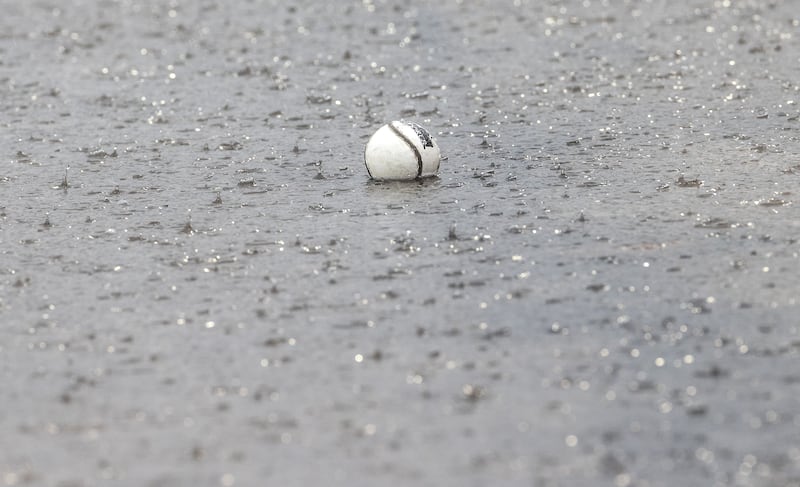The split season in the GAA is still on trial, officially, but it doesn’t really matter what anyone thinks now.
The people that don’t like it don’t have a better idea and the people that brought it in don’t either. The only arguments now are over tweaks. Could the All-Ireland finals be pushed back by another week? No, they said. Please? No.
In his presentation speech after both All-Ireland finals the GAA president Larry McCarthy mentioned the upcoming club season, as if the new calendar still needed to be promoted. Is everybody convinced? No. Is it working like they hoped it would? That depends where you look.
In passing, in his hurling final speech, McCarthy mentioned “good conditions” for club players, but nobody can write a weather cheque and hope to have it cashed these days. October is the peak season for county finals and 2022 produced the wettest October on record. This October opened with temperatures of 24 degrees on the east coast and will probably end up as the new record holder for rainfall.
No magic for Carlo Ancelotti as Real Madrid fail to come back against Arsenal
St Pat’s and Shamrock Rovers thrilling in the rain, but the ‘UnderDrogs’ stay top: what we learned from Friday’s League of Ireland action
Dean Rock: In the grand scheme of things, the Leinster championship doesn’t really matter to Dublin
Munster and Leinster hurling championships: Full fixture list and who to watch out for
But July this year was also the wettest on record, and so was March. One of the biggest advances in the GAA over the last 20 or 30 years has been the enhanced quality of the pitches, many of which are sand-based now and designed to absorb the sky falling in, within reason.
Over the years, foul weather for the conclusion of the club championships was often raised by advocates for a reformed calendar. The most compelling argument, though, was that club players needed certainty around dates for their championship matches so that they could make other plans.
That clarity has been established. Master fixture lists are published at the beginning of the year and emergency changes are no longer subject to bartering. The leverage that used to be exercised by stag weekends and weddings has been decommissioned.
There were plenty of stories this year of players arriving back late from a lucrative summer sojourn in the United States, but there were no reports of matches being delayed on this account.
Like with every other major structural change, though, there are unintended consequences. So, what does the club season look like now? Seven months of training, league matches and challenge games, and then a month of hectic flapping while clubs try to keep their seasons airborne.

Round robin systems are the norm everywhere now – except Tyrone – and in that format if you lose your first two games your season is effectively over in a fortnight, or less. The only thing on the horizon is a relegation play-off. It feels reductive and brutal.
One of the good things about the old chaotic, reactive calendar was that the feelings generated by the championship had a longer life and more room to breathe. A first round game in late April or early May added a focus to preseason training, and injected energy into early season league matches.
Win, and you had time to luxuriate and look ahead; lose and you had the opportunity to take stock and make corrections. Even with an utterly dysfunctional calendar it still felt like the year was stretching out in front of you.
Now the first two-thirds of the club year is full of decaffeinated matches and the championship phase of the season is consumed like a shot of espresso.
What it exposes again is the GAA’s ingrained, institutionalised, cultural indifference to league competitions. At club level, players are always guaranteed more league games than championship games, even in a winning year, but that has no impact on attitudes. Unlike every other team sport, the league doesn’t really matter.
The sheer lunacy of that outlook has been magnified by the split season. Clubs now are waiting until August for the only the competition that matters to them. By then, they will have spent the spring and summer fulfilling league fixtures that are not going to define their season, or their mood, one way or another.
In an ideal world, league performance should in some way be linked to the championship, like it is now for intercounty football. But, with the new calendar, clubs that have intercounty players in their ranks have no access to them for league games, removing that as an equitable, enforceable option.
So, everyone adapts. Even the proponents of the split season didn’t claim it was a utopian solution. Croke Park was tired of being in the middle, fired on from all sides. They understood the threat to their promotional firepower by shutting down the intercounty season in the middle of the summer and were prepared to take that hit.
They also knew that they had consistently failed to deliver an integrated fixture list that was seen to work or made to work by its constituent county boards.
Ultimately, the split season was a bottom-up solution for an organisation that always espoused the primacy of the club player but didn’t always deliver on that creed.

The split season will be revisited at the end of the trial period, but it won’t be reversed.
For all the grumbling about All-Ireland finals in July, and the intercounty championships being squeezed into a corset, the only alternative is give and take. To allow the intercounty game more latitude would mean invading the ground that has been newly staked out for clubs. It is a binary transaction that nobody has the stomach for now.
Club players have been incredibly tolerant over the years; for a long time, that tolerance was taken for granted. The feelings that tied them to their clubs were always assumed, though not always expressed.
In conversation last week the former Cork hurler Conor O’Sullivan spoke about his club Sars. He named six of his closest friends, all of whom he has hurled with since they were kids. In adult life, they’ve stood at the altar for each other’s weddings and stood as godfathers for each other’s children. Sars was the constant in their lives.
“I got a bit introspective last week [after Sars won the county], thinking what it meant, and stuff,” he said.
“None of us [naming his six friends] emigrated or moved away. I’m a home bird – but then I was thinking, ‘Why am I a home bird?’ I don’t know if Sars is the reason for it – but if you drill into it, it probably is.”
There are many, many thousands like O’Sullivan. The split season is an imperfect solution to an intractable problem. Any better ideas? No?

















